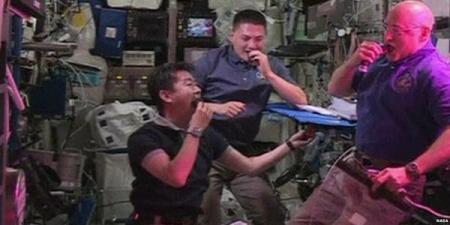Today marks 15 years of continued life in space aboard the International Space station! From CNN:
The station has been continuously inhabited since, and on Monday, to celebrate the anniversary, the current crew of Expedition 44 will talk live on camera.
Two of them, NASA’s Scott Kelly and Roscosmos’ Mikhail Kornienko, are on a one-year mission to test the effects on the human body of long-term stays in space. The experiment is a precursor to sending people to Mars.
Alone Time
When you live and work at your office and can’t exactly go anywhere else, alone time is crucial.
“We each have a crew quarters about the size of a phone booth and you can go there to relax and sleep, email and listen to music and get your wits about you,” Wheelock said.
Hobbies
Having a hobby helps, too. Wheelock said he kept a journal and wrote poetry. Anderson played the keyboard and wrote music.
What’s That Smell?
The sterile environment of space has a funny smell.
“Your sense of smell is a little bit dulled,” he said. “Everything smells sort of like the exhaust on a computer or TV. … That plastic burning smell.”
Condiments Are ‘Gold’
Space cuisine just doesn’t compare to the pizza, barbecue and hot wings back on Earth, but condiments can help kick a meal up a notch.
“They did have little packets of condiments that were like gold,” Wheelock said. “I remember a squeeze bottle of olive oil and balsamic vinegar and I added that to my food and it brought that flavor back.”
Two other staples, salt and pepper, come in liquid form, Wheelock said, because otherwise the grains could float into an astronaut’s eyes as they’re sitting down for a meal.
Pre-Position Your Toilet Paper
Seriously.
“It’s important to minimize the disruption of the bathroom experience because toilet paper doesn’t hang on the wall like it does on Earth,” Anderson said. “It doesn’t roll off that cardboard tube.”
Drinking Water
Some people don’t mind the recycled water at the International Space Station, which Wheelock said has little taste to it. Anderson said he didn’t like drinking plain water, so he added coffee, tea or Tang to give it a boost of flavor.
Fresh Fruit
Every time a cargo resupply mission arrived, fresh fruit and vegetables would be at the top of the load, Wheelock said. He ate an orange and enjoyed the aroma in the otherwise sterile space environment. He also remembered having a very new appreciation for a fresh apple he was given.
“I felt like Tom Hanks in the movie ‘Castaway,’ with the volleyball,” he said of the movie, in which Hanks plays a man stranded on an island with a volleyball named Wilson as his only friend. “I kept that Apple for two or three weeks.”
Best Photo Spot
When Anderson was at the ISS, he said the best window for taking photos was in the Russian module. Now, the best spot is at the cupola observational module, the dome-shaped lookout that was launched to the ISS in 2010.
Noises
The isolation of space has some astronauts missing the little noises on Earth that are easy to take for granted.
“The things I missed the most were sounds of birds singing, children playing, the rain,” Wheelock said.
Know You’re Human
Mistakes will happen, Wheelock said.
“I knew I would make mistakes because I’m a human, so I said, ‘I just hope mine are little ones.’ You feel that weightiness as well. NASA has put a lot of money into you and people are looking up to you to get the job done and you want to do it with style and grace and be a team player and a hard worker,” he said.
Group Bonding
With the Russians living and working in their own module, it was possible to go an entire day without seeing cosmonaut colleagues, Wheelock said. His solution for bringing everyone together: Crew dinners every night.
“We had an agreement — each day, breakfast and lunch were on your own,” he said, “But we would have dinner together every night. Sometimes we’d go to Russia for dinner, sometimes the U.S. [area].”
Celebrate
With astronauts spending months at the space station, plenty of birthdays and holidays are celebrated. Anderson said he was even to pull off a video surprise for his wife’s birthday. Using some balloons that were left behind at the station, he said he surprised his wife on a video feed as she was giving a tour at the Johnson Space Center.
“I played our love song from when we dated,” he said. “I set the bar pretty high for males across the country.”
Bad Days
“Over the course of six months, you do experience people having harder days than others and sometimes it may be bad or sad news from Earth or frustration with some task or someone ticks someone off,” Wheelock said. “As the commander, I was sort of hyper-sensitive to watching everybody and keeping a close eye on how they responded to each other. It is a real exercise in developing and nurturing and encouraging a team effort.”
Take Care of Each Other
Astronauts spend as long as two years training together before a mission, but space can be an isolating experience. Wheelock said everyone would try to look out for their colleagues and rally around them if they were having a tough day.
Enjoy It
Wheelock and Anderson both have great memories about their time spent in space and know they’re some of the lucky few who truly know what it’s like to live and work at the International Space Station.
“To see this piece of engineering artwork is quite amazing,” Wheelock said. “It really sets in right away — the feeling that you’re on borrowed time there.”




